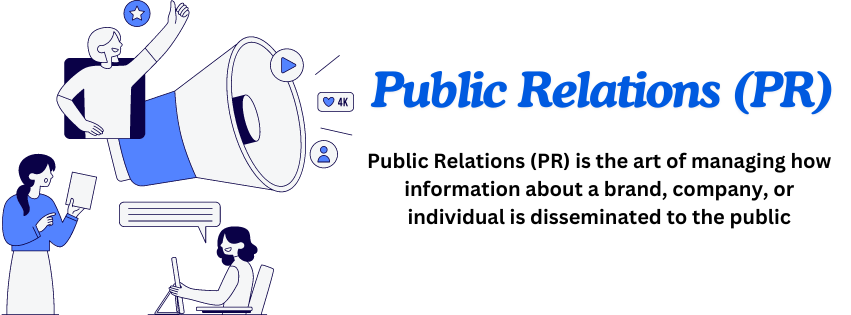Public Relations (PR) is the art of managing how information about a brand, company, or individual is disseminated to the public. PR professionals work to craft positive narratives, mitigate negative ones, and build strong relationships with media, stakeholders, and the public. In a world where reputation is key to success, effective PR strategies can make or break a brand.
In this blog, we’ll explore what public relations is, why it’s important, and key strategies for effective PR campaigns.

What is Public Relations?
Public Relations involves strategically managing communication between an organization and its audiences to maintain a positive public image. PR activities can include media relations, crisis communication, event coordination, influencer collaborations, and more. Unlike advertising, PR doesn’t involve paid media placements. Instead, it focuses on generating organic media coverage, building credibility, and fostering trust.
The goal of PR is to:
- Enhance a brand’s reputation.
- Shape public perception.
- Build relationships with key stakeholders (customers, investors, media, employees, etc.).
- Manage crises effectively.
- Create opportunities for positive media coverage.
Why Public Relations is Important
Builds Trust and Credibility
- PR helps establish a company as an authority in its industry, providing credibility through media coverage, speaking opportunities, and thought leadership. When the public sees a brand featured positively in trusted publications or news outlets, it enhances the brand’s reputation.
Manages Brand Image
- PR allows brands to shape their narrative and communicate their values, mission, and vision clearly to the public. This ensures that the public perceives the brand the way the company intends.
Crisis Management
- In times of crisis, effective PR strategies are crucial. Whether it’s managing a product recall, responding to negative press, or addressing internal issues, PR helps control the narrative and limit potential damage to the brand’s reputation.
Increases Media Coverage
- Positive media coverage can significantly boost brand awareness and reach new audiences. PR professionals build relationships with journalists and media outlets to secure feature articles, interviews, and product reviews that highlight the brand’s strengths.
Supports Marketing Efforts
- PR complements marketing by amplifying a brand’s message organically. While marketing campaigns may focus on direct sales, PR helps build long-term brand equity by creating a positive, lasting image in the public eye.
Key Public Relations Strategies
Media Relations
- Media relations is the cornerstone of PR. It involves building and maintaining relationships with journalists, bloggers, editors, and influencers to secure positive media coverage. PR professionals pitch stories, write press releases, and provide media kits to help the press cover their clients effectively.
- Pro Tip: Craft pitches that are relevant and newsworthy. Understand the journalist’s beat and tailor your message to suit their audience.
Press Releases
- A press release is a formal announcement sent to media outlets to inform them about significant events or updates. This could include product launches, company milestones, partnerships, or corporate social responsibility initiatives. A well-written press release can lead to media coverage in newspapers, online platforms, and TV news.
Crisis Communication
- Every company may face a PR crisis at some point, and how it is handled can have lasting effects on its reputation. A crisis communication plan outlines how to respond when things go wrong. It should include designated spokespeople, clear messaging, and a strategy for dealing with the media and public inquiries.
- Key Tip: Stay transparent, take responsibility if necessary, and offer a solution to the problem.
Thought Leadership
- Positioning company executives as thought leaders is a powerful way to build authority and trust. This can be achieved through speaking engagements at industry conferences, writing guest articles, or participating in interviews and podcasts. Thought leadership builds a positive association between the brand and expertise in its field.
Influencer and Community Relations
- Partnering with influencers, community leaders, or industry experts can enhance a brand’s visibility and reputation. These collaborations allow brands to tap into the influencer’s audience and credibility, increasing trust and awareness.
Event PR
- Events such as product launches, charity fundraisers, or corporate conferences provide excellent PR opportunities. Inviting media to cover the event, live streaming it on social platforms, or creating exclusive experiences for journalists can generate buzz and boost media attention.
- Tip: Use events to showcase the brand’s mission or values in a way that resonates with your audience and aligns with the media’s interests.
Corporate Social Responsibility (CSR)
- A strong CSR program can enhance a company’s public image by showing that it is committed to making a positive social or environmental impact. Companies involved in charitable initiatives, sustainability efforts, or community support are often viewed more favorably by the public.
- Promoting CSR activities through press releases, social media, or dedicated web pages can strengthen relationships with consumers and the press.
Social Media PR
- Social media platforms have become key channels for PR efforts. Brands use platforms like Twitter, Instagram, and LinkedIn to engage with their audience, respond to questions or concerns, and share news. Social media PR allows for real-time interaction and a more personal connection with the public.
- Pro Tip: Monitor social media closely for mentions of your brand and respond quickly to both positive and negative feedback.
How to Build a Successful PR Campaign
Define Your Objectives
- Before launching a PR campaign, identify clear goals. Are you looking to build brand awareness? Drive media coverage? Manage a crisis? Knowing your objectives will help guide your strategy and measure the campaign’s success.
Understand Your Audience
- Your PR messages need to resonate with the target audience. Understand their needs, pain points, and interests so that your communication is effective. Tailor your PR efforts to different audiences, whether it’s consumers, investors, or media professionals.
raft a Strong Narrative
- Every brand has a story, and telling it well is key to successful PR. Develop a compelling narrative that communicates your brand’s mission, values, and vision in a way that engages the audience. Your narrative should be consistent across all channels, from media interviews to social media posts.
Choose the Right PR Channels
- Not all PR channels will be relevant for every campaign. Identify which platforms or mediums will best reach your target audience. Whether it’s traditional media (newspapers, TV) or digital platforms (blogs, social media), focus on the channels that align with your goals.
Build Relationships with the Media
- Cultivating relationships with journalists and influencers in your industry is crucial. Regular communication, personalized pitches, and understanding what’s important to them will improve your chances of getting your stories published.
Monitor and Measure Results
- After the campaign is live, monitor its performance. Use media tracking tools to see where your press releases or mentions have been featured. Evaluate key metrics such as media impressions, website traffic, social media engagement, and overall brand sentiment to gauge success.
The Evolving Role of PR in the Digital Age
With the rise of digital media, PR has evolved significantly. The line between traditional PR and digital marketing is blurring, as both require a mix of storytelling, content creation, and audience engagement. Social media and influencer marketing are now integral to modern PR campaigns, and the focus is increasingly on building genuine, long-term relationships with audiences rather than one-off media hits.
Conclusion
Public Relations is a powerful tool that helps brands shape their image, build trust, and communicate effectively with their audience. From managing crises to crafting compelling stories, PR plays a vital role in a company’s success. By leveraging media relations, thought leadership, and digital platforms, businesses can enhance their visibility and strengthen their reputation in an increasingly competitive marketplace.
Ready to elevate your brand through effective PR? Start by building strong relationships, crafting compelling narratives, and keeping your communication authentic and transparent. Your audience—and your reputation—will thank you!




